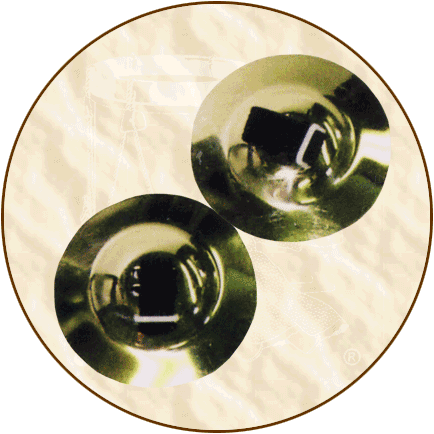.
Continued from product description on
Folk Instruments' Page Four...
Historical
Background: Finger cymbals are a member of the percussion
musical instrument family. They are primarily used by Middle
Eastern musicians and dancers (as well as others who perform
this genre of dance). In fact, Middle Eastern dancers are also
considered musicians! The intricate musical patterns finger cymbals
create, and their sparkling sound quality make them an indispensable
part of Middle Eastern music and dance.
Finger cymbals are an important aspect of Middle Eastern dance
because they express the sense of rhythm and feeling for tempo.
The manner of using finger cymbals is similar to when flamenco
dancers play castanets or tap dancers who perform variations
of rhythm with the taps on their shoes.
Basically, finger cymbals are small brass cymbals (1-1/2 to
4 inches in diameter) that have finger loops. They are played
in pairs. Dancers place a finger cymbal on each thumb and either
the index or ring finger of each hand. The finger loops are placed
between the knuckle and the fingernail. Different tones can be
achieved by using either finger or clashing the cymbals together
at various angles. Sometimes finger cymbals are played like orchestral
cymbals by holding one in each hand. Either way, it takes a pair
of finger cymbals to produce a sound.
Finger cymbals go by names other than the one used in Europe
and the United States. In Turkey, they are called "zils."
Arabic names are "sil sil" and "sunouj."
Egyptians call them "sagat" and, in Farsi, the Persian
word is "salasih." The Greek word for "cymbal"
is "kymbala." Cymbal (also "cimbel" and "cymbel")
is derived from the Latin word "cymbalum" ("cymala"
is plural for a pair of cymbals).
Finger cymbals have existed since antiquity and were used
in religious ceremonies. There are engravings of finger cymbals
in ancient Mesopotamia depicting their use in dance. Finger cymbals
were also used for religious music, funeral rites, in times of
celebration (such as a victory), and even for magical purposes!
Ancient Greeks played finger cymbals and, in Turkey, dancers
have been playing them since the 15th century.
It is believed that finger cymbals originated in Asia, where
many forms of cymbals have been used in the ancient East. From
there, they probably traveled the trade routes to the Middle
East. By 1100 B.C., finger cymbals are known to have been used
in Israel. The actual use of cymbals tied to the middle fingers
and thumbs was recorded around 500 A.D.
Finger cymbals have existed in Europe since the Middle Ages
and were introduced by the Saracens, who brought them to Spain
and southern Italy. Portrayals of cymbals can be found in medieval
miniatures up to the 15th century when they disappeared (probably
because the art of hammering had been lost). However, they returned
to Europe during the 17th century after the Turkish wars. (By
this time, Turkey had long been famous for producing excellent
cymbals.)
Cymbal music was also popularized by Turkish military bands
which played Janissary music. This type of music is uniquely
characterized by the ensemble of noisy and rhythmic instruments
used. Besides cymbals, others instruments used in Janissary music
are the bell-tree, bass drum, side drum, tambourine, and triangle.
By the beginning of the 18th century, European military bands
were imitating Turkish military music.
During the 17th century, and on rare occasions, Turkish-made
cymbals were given parts in operatic orchestras. Christoph Willibald
Gluck asked for cymbals to be used for his 1779 opera "Iphigénie
en Tauride." Perhaps the most well-known use of cymbals
during this time is Wolfgang Amadeus Mozart's 1782 Turkish opera
"The Abduction from the Seraglio." But it wasn't until
the 19th century that the cymbals secured a permanent place in
the percussion section of an orchestra. Lugwig van Beethoven
("Ninth Symphony"), Georges Bizet ("Carmen"),
Franz Liszt, and Richard Wagner are just some of the composers
who found effective orchestral uses for cymbals.
Fun
Fact: Belly dancers are judged more by how well they play
finger cymbals than dancing. A belly dancer's musical talent
and skills with finger cymbals are considered the difference
between a good belly dancer and a great one!













